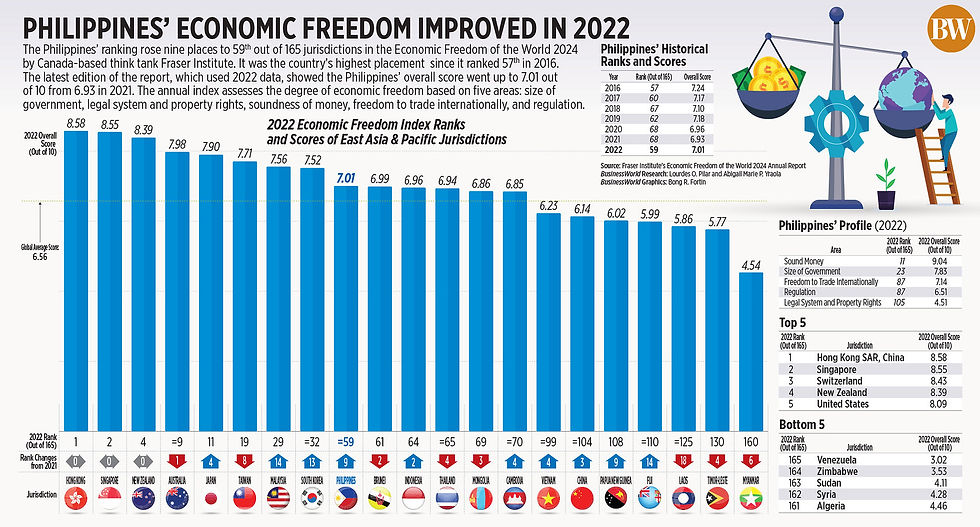- Ziggurat Realestatecorp

- Nov 4, 2024
- 4 min read
A Kamala Harris presidency would be more beneficial to the Philippine economy, analysts said, noting the potential impact on monetary policy, trade and other economic indicators.
“The implications of a Trump or Harris presidency on the Philippines can vary significantly, particularly in terms of interest rates, foreign exchange, and the overall economy,” Jonathan L. Ravelas, senior adviser at professional service firm Reyes Tacandong & Co., said.
Republican candidate Donald J. Trump faces Vice-President and Democratic nominee Ms. Harris in the US presidential elections on Nov. 5.
More than 75 million Americans have already cast their ballots, according to the Election Lab at the University of Florida, Reuters reported.
Mr. Ravelas noted the impact of the US elections on the US Federal Reserve and possibly the Philippines’ own monetary policy.
“A Harris presidency is expected to maintain a more stable economic policy, similar to the current administration. This could lead to a more predictable interest rate environment, with the US Federal Reserve potentially continuing its rate-cutting cycle,” he said.

The Bangko Sentral ng Pilipinas (BSP) kicked off its easing cycle in August, delivering a total of 50 basis points (bps) worth of rate cuts since then. BSP chief Eli M. Remolona, Jr. has also signaled further easing moving forward.
The Fed likewise began cutting interest rates in September, its first time reducing rates in four years. It delivered a larger-than-expected half-percentage-point cut, bringing the Fed funds rate to the 4.75%-5% range.
Markets are anticipating further rate cuts from the US central bank, but at a more modest pace of 25 bps.
On the other hand, Mr. Ravelas said a Trump win could “lead to higher interest rates in the US due to potential inflationary pressures from increased fiscal spending and tariffs.”
The former US President plans to implement stringent trade restrictions including a 10-20% universal tariff on all imports as well as a tariff of 60% or higher on Chinese goods.
On the other hand, Ms. Harris has opposed the concept of a universal tariff, instead favoring “strategic tariffs to help workers or punish trade adversaries,” Reuters reported.
The Philippine economy is seen to more likely thrive under a Harris presidency amid her less restrictive trade policies, analysts said.
“The Philippine economy could benefit from policy continuity under Harris. Her administration is likely to focus on strengthening economic ties and maintaining stable trade relations, which could support Philippine exports and the business process outsourcing (BPO) sector,” Mr. Ravelas said.
“A Trump presidency could introduce more economic uncertainty and potential challenges for the Philippines, while a Harris presidency might offer more stability and continuity in economic policies.”
ANZ Research said that while both candidates’ platforms are restrictive on trade with China, each have different approaches.
“Trump’s stance tends to be ‘American only,’ while Harris will likely extend Biden’s ‘friend shoring,’” it said in a report.
Data from ANZ showed that during the Trump and Biden terms, the United States imported less from mainland China and more from the rest of Asia. However, a second Trump term would “likely target Asia more broadly.”
“Biden’s administration has maintained the tariffs imposed under Trump. He also strengthened export controls,” it said.
“This policy mix has changed global and Asian trade patterns. Between June 2018 and September 2024, US goods imports from mainland China slumped by 20%. The share of US total imports from mainland China fell 8% to 14%.”
ANZ noted that Ms. Harris is likely to favor the Indo-Pacific Framework proposed by Mr. Biden, while Mr. Trump is not in support of multilateral agreements, citing his withdrawal from the Trans-Pacific partnership.
“Trump’s current campaign proposals are more severe than the actual trade policies he implemented as president. If his current proposal of a 60% tariff on all Chinese imports and a 10-20% universal baseline tariff become a reality, the average US tariff would rise to 17.7%, a level not seen since 1934,” ANZ said.
This would have consequences such as higher prices for US consumers; margin compression for Chinese exporters and US importers; as well as a negative effect on the rest of Asia despite a supply-chain diversion from China, it added.
Mr. Ravelas noted that Mr. Trump’s protectionist policies “could hurt the Philippine economy by reducing exports to the US and affecting remittances from Filipino workers in the US.”
The United States remains the top destination of Philippine-made goods. In August, it accounted for close to 20% of exports during the month.
The world’s most powerful economy also typically accounts for nearly half of overall monthly remittances to the Philippines.
Meanwhile, the peso is also seen to be under less pressure if Ms. Harris assumes the presidency.
“The Philippine peso might experience less volatility under a Harris presidency. A stable US economic policy could lead to a more predictable exchange rate environment, benefiting the Philippine peso,” Mr. Ravelas said.
Under a Trump administration, the local currency could depreciate against the dollar if US interest rates rise.
“Investors might prefer the higher returns in the US, as well as the impact of tariffs could lead to competitive devaluation.”
The peso closed at P58.10 per dollar on Thursday, rising by 13 centavos from its P58.23 finish on Wednesday. Peso trading was closed on Friday due to the All Saints’ and Souls’ Day weekend.
The peso has returned to the P58-per-dollar level since August.
Source: Business World



